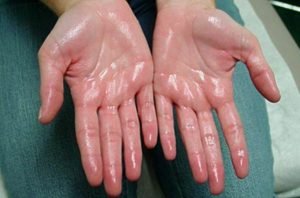

The excessive and uncontrollable problem of sweating palms or hands is called palmar hyperhidrosis. It’s a medical condition that’s not only embarrassing but can cause extreme stress and lack of confidence. With this condition, one must deal with wet or slippery handshakes and ruined paperwork; it can affect how you relate socially and in your career.
According to a study, sweating palms are not merely a cosmetic inconvenience. It’s a serious medical condition that’s disabling. It affects a patient’s daily activities, their work productivity, personal relationships and emotional well-being.

Why are they so sweaty?
Palmar hyperhidrosis victims are reluctant to touch loved ones or shake hands. They also have difficulty holding things, gripping equipment and sometimes they soil electronic devices. Writing and counting cash also becomes difficult.
The symptoms vary from one sufferer to another. There are also trigger factors that should be avoided.
The hands contain a high concentration of eccrine sweat glands. These are connected to our nervous system which kicks in when we get stressed.
There are two types of hyperhidrosis: the primary focal and secondary generalized.
Primary means that no obvious cause is identified. Hereditary predispositions may be the cause. Those affected are healthy and may get excessive perspiration on other locations such as armpits, feet, and face.
This kind of profuse or excessive sweating is triggered by emotional causes like nervousness, anger, anxiety, and fear. These reactions cause the sympathetic nervous system to get overactive.
Perspiration reduces when one sleeps in this case.
In this case, an underlying cause can be identified. Some of these include:
Those with this problem can improve their way of life by seeking out treatment. Some of the treatment options available are:
Antiperspirants are your first defense. They are non-invasive, applied on the skin and available in different strengths. You can purchase them either over the counter or get prescription antiperspirants from a dermatologist.
To optimize the effectiveness of the antiperspirants and minimize any irritation:
If the antiperspirants do not cure your sweaty palms, iontophoresis is your next best option. Its success rate is impressive especially if used correctly and with the right device. This is according to a published study done on the effect of treating sweaty palms with iontophoresis.
Iontophoresis can be done at home or at the doctor’s office. The physician will use a medical device that uses pans of water to conduct mild electric current through the surface of the skin.
Physicians believe that the mineral particles in the water and the electric current microscopically thicken the skins outer layer. This blocks the sweat flow to the surface of the skin. Once blocked, sweat production is turned off.
Another safe treatment is Botox. A medical professional will inject the Botox into your palms which reduces sweating dramatically. The effects of this can last up to 6 months although the injections may be painful.
Medical professionals, however, have discovered a way to reduce the pain by using a simple vibration or icing technique. Be careful though since discomforts during injections can cause drawbacks for the Botox treatment.
There are oral medications available to cure sweaty palms. Oxybutynin and propantheline bromide are anticholinergic tablets one can take. This, however, has side effects including dry mouth, constipation, and drowsiness.
Other medications include oral glycopyrrolate, clonazepam, propranolol, and gabapentin. This, however, provides relief only for few days or weeks.
This should be considered only as a last resort. There are significant risks associated with ETS especially a compensatory sweating side effect. This is when large areas of the body get irreversible excessive sweating. ETS for pulmonary sweating should only be used in extreme cases after all other options have failed.
You can also try a combination of the antiperspirants, Botox, and iontophoresis, to manage this problem before seeking out ETS.